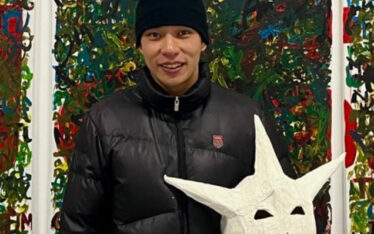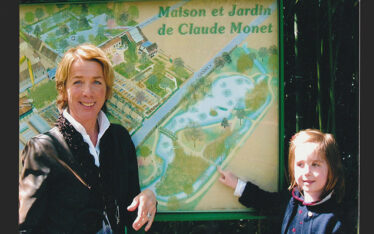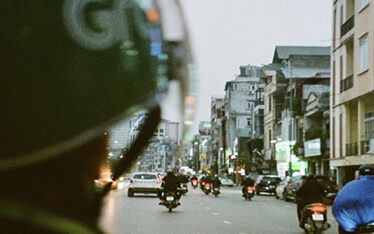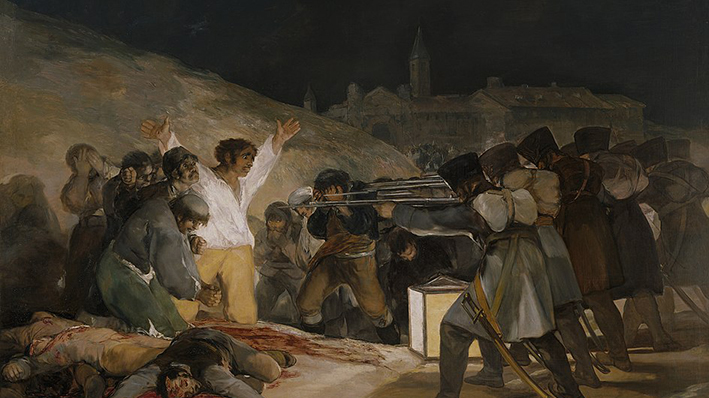
Photo by Boturus Courtesy of Smart History.org
Probing Spain – Pt. I
The fourteen (possibly fifteen) works attributed to Francisco Goya’s late black period, ‘Pinturas Negras‘ are bleak, brilliant and intense. They hang in the Prado Museum in central Madrid.
Although clearly masterpieces, without firm evidence, it becomes difficult to prove they are in fact by Goya.
Most prominent of the lot is the widely acclaimed “The Third of May” (1808), considered by many to be the very first modern painting. It depicts a well-dressed Spanish civilian, on his knees with his arms raised, facing his imminent death at the hands of a firing squad from Napoleon’s occupying forces.
_________________________
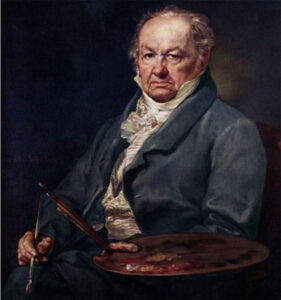
Courtesy of FranciscoGoya.com
Goya, the most important Spanish artist of the late 18th and early 19th centuries died in 1828 and was buried at La Chartreuse in Bordeaux.
Seventy years later, however, when his remains were exhumed by the French to be returned to his native Spain, there was not a trace of Goya’s skull. It was totally missing.
If someone had beheaded him: then who, when and why? No one ever admitted to such a ghastly deed. Never has there been any mention. No record. Had it happened before he was buried? To this day, the answers remain equally elusive.
__________________________
So, the artist’s headless body was shipped as is, back to Madrid and reburied under the Ermita de San Antonio de la Florida chapel near the Prado. Beneath the stunning frescoes Goya had painted years earlier on the ceiling and under the dome, it seemed entirely appropriate for the chapel to be his final resting place.
That evening, after my haunting research, I returned to the present and rushed across town to attend a local fashion show at an art gallery. An empty exhibition hall, designated a changing room for the event, was a mess. Clothes lay strewn about everywhere. Not even a minimal semblance of order existed.
Pilar, my Spanish model friend who invited me, however, performed pure magic. With the help of her colleagues, she managed to keep the show running like clockwork. Never missing a beat. No way the audience could have imagined what transpired behind-the-scenes. Wounded egos, that verbally clashed, went unnoticed.
_________________________
Two models, alone in back, remained out of view by anyone in the main gallery. Ever playful at first, the pair engaged in, what soon became, a vicious tug-of-war. I was certain the object, a stunning, one-of-a-kind dress, would get shredded in the struggle.
Luckily, an Israeli model was able to distract Pilar and Veronica long enough to rescue the garment.
Wisely electing to move on, the two women changed back into the casual street clothes they’d arrived in. And as they did, Pilar signaled me we should head for the door. Within seconds, once on the street, we leapt into her little yellow Seat, a Spanish, Fiat-like car, and took off through a downpour that soon slowed us and the surrounding traffic to a crawl.
__________________________
Outside in this horrific weather, a solitary city worker, oblivious to the storm, was busy hosing down the sidewalks in a local school yard across the way.
“The guy has to be nuts,” I blurted out to Pilar.
“Not at all,” she said, laughing. “Just doing his job.”
___________________________
“Washing the pavement? In the rain?”
“Not his fault. He only gets paid when he works. No hosing, no paycheck.”
“Makes no sense,” I shrugged.
__________________________
“Same as most things in life.”
I had a hard time keeping up with all the contradictions.
By the weekend, however, the rain showed signs of letting up. So, on Sunday, Pilar took me to the famous El Rastro street market as planned. There, we soon found ourselves packed into a crowd of peaceful protestors who had appeared everywhere. Seconds later, we had inadvertently been merged into a spontaneous demonstration.
___________________________
Voices of angry leftist students chanted. The best I could understand, they were demanding amnesty for political prisoners. Then, without warning, row after row of tightly gripped batons suddenly came crashing down and shattering bone. Protestors scattered in every direction. They shielded their heads with their placards, using these improv shields to protect themselves from riot police and Federales, who showed no mercy whatsoever.
Wooden batons aggressively bashed away, slamming into the nearest skulls. I cringed as my stomach cramped. I felt we were reliving The Third of May. Just then a shower of rubber bullets sprayed the air. The crowd completely panicked, desperate to escape.
Shoppers dropped their packages on the spot. People tripped and fell and trampled one another as they desperately sought out safety. Of any sorts.
_________________________
Absolute chaos prevailed. I got torn from Pilar, Veronica and the others. Set virtually adrift on a surreal conveyor belt of stumbling humanity and swept up into the flow.
Against all odds, ten minutes later, Pilar and Veronica spotted me across the market. Luck suddenly showed us her face. On spotting the two frantically waving, I threw my hand high into the air to wave back and signal for us to reconnect.
By evening, we had made our way safely back to Pilar’s. There, we all pitched in to help her prepare a makeshift Paella dinner of saffron rice and roasted vegetables. With no time to shop for seafood or meat, we just added herbs and spices. After the tasty meal and some reassuring conversation, our communal blood pressure started to calm and once again resemble something close to normal.
_________________________
Tuesday morning, awakening at dawn, I got it together and flew south to the Costa del Sol. On landing in Malaga, I rented a shiny new Mini at the airport then drove a few miles to check into a small, hotel nearby. The place was well worth it. A find. Full bar in the lobby. Clean sparkling rooms. Fresh breakfast. Owned by a retired British couple. Both charming and helpful.
After lunch, I started up the Mini and ventured forth to explore a tiny bit of the region. I had no intention, however, of stopping in either of the two most popular locations – overly developed Torremolinos or over-priced Marbella. For me, both had long lost their authenticity. They’d surrendered it and sold out. Each preferred to embrace its own level of commercialism.
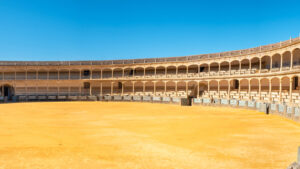
A.Nekrasova/Shutterstock.com
I instead elected to follow the late Ernest Hemingway’s lead, heading for the windy mountain road up to Ronda. Rather than navigate the two-lane, black top after dark, I wound my way up, covering the route and reaching the legendary Plaza de Toros de Ronda, the oldest bullring in Spain just before sunset.
___________________________
The next day I awoke refreshed and energized. Opting to leave the Mini at the hotel, I hiked, explored and even bought a used version of Hemingway’s Spanish Civil War classic: “For Whom the Bell Tolls”. With book in hand, I sat myself down outside a café, relaxed and read for a stretch. After a potent cup of café con leche, I pulled out my journal and began to write, totally surprising myself at how easily the words flowed.
Totally absorbed in the process, I never noticed the waitress patiently hovering over me. She eyed my dog-eared edition of Hemingway, assuming I had gone through it several times cover to cover. I chuckled, feeling bad at having to disappoint her but equally happy at this spontaneous way we used to break the ice.
Turns out, Martina was quite familiar with the novel and with the Spanish revolutionary history of the 1930s. Her great grandparents had lost a good part of their family fighting for the Republicans in the conflict. Without ever intending to do so, we soon found ourselves engaged in an all-consuming dialogue about that volatile period and the people’s struggle to reestablish democracy.
__________________________
Martina’s shift that day was supposed to end before lunch. But wanting to continue our conversation, we decided to keep chatting and grab a bite together after she had finished.
Although honestly happy for both the company and our conversation, I most appreciated her subtle sense of humor. A touch disarming and self-deprecating. Along with her astute analytical insights.
Martina believed the 1930s spread of political extremism, both left and right, had contributed the inevitable lead-in to World War II. The two of us now feared history would repeat itself and the 2030s could unleash a twenty-first-century version of this tragic past.
__________________________
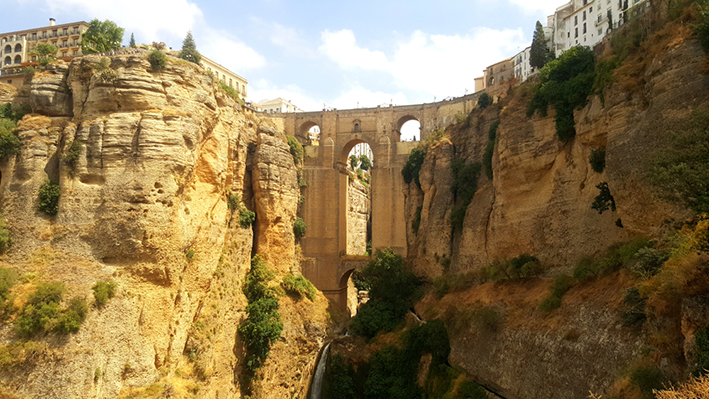
J.Van.Immissen/Shutterstock.com
Ronda, as stunning as it appears, at first seemed completely inaccessible to me. And yet as I wandered about, chatting with Martina, the town soon gave off an unexpected familiarity.
As we circled the outside of the bullring, I sensed the inherent attraction it had held for Hemingway and others. I had to resist my instincts and not be drawn in.
The two of us were strangers sharing the moment. A moment neither of us wanted to end.
__________________________
I reacted spontaneously and invited Martina to join me to ride along the coast in the Mini. Initially an expression of surprise appeared on her face. She appeared a touch perplexed.
“Then you’ll come stay with me tonight,” announced Martina matter-of-factly as if we had already agreed. “That way we can get an early start in the morning.”
Neither of us spoke as we stood up, clutched each other’s hand and drew our shoulders closer together in a warm inviting embrace.
About the Article
Reflecting back from the Spanish Civil War in the 1930s to the 19th-century and the darkness of Francisco Goya’s insightful world view.
Probing Spain – Pt. II

